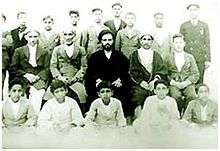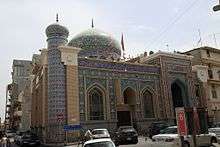Ajam of Bahrain
The Ajam of Bahrain (Arabic: عجم البحرین), also known as Persians of Bahrain or Iranians of Bahrain, are an ethnic group in Bahrain composed of Shia Bahraini citizens of Persian/Iranian background.[4]
 Iranian School in Bahrain 1939 | |
| Total population | |
|---|---|
| 80,000-100,000[1] 14% of Bahraini citizen population.[2] | |
| Languages | |
| Persian, Ajami Arabic[3] | |
| Religion | |
| Twelver Shi'a Islam | |
| Related ethnic groups | |
| Lurs, 'Ajam of Kuwait, Huwala, Persians |
The Ajam are estimated to number around 100,000,[1] 14% of Bahraini citizen population, who mostly adhere to the Shia sect of Islam.[1] They are mostly bilingual in Persian and Arabic.
History
Persian migration into Bahrain goes back to the days of the Sassanid and Achaemenid Persian empire, though in modern times there has been a constant migration for hundreds of years.[5] There has always been a migration of Persian-speaking Shi'a into Bahrain.[6]
In 1910, the Persian community funded and opened a private school, Al-Ittihad school, that taught Persian, besides other subjects.[7] In the Manama Souq, many Persians were clustered in the neighborhood of Mushbir. However they resettled in other areas with the development of new towns and expansion of villages during the reign of Isa bin Salman Al Khalifa. Today, a significant number is based in Muharraq's Shia enclaves and Bahrain Island's modernized Shia towns.
Matam Al-Ajam Al-Kabeer


Matam Al-Ajam Al-Kabeer (Arabic:مأتم العجم الكبير) is the first Persian Matam and the largest such matam in Bahrain. It was founded in Fareej el-Makharqa by Abdul-Nabi Al-Kazerooni, a rich Persian merchant who was a representative of the Persian community in the council of the hakim Isa ibn Ali Al Khalifa.[8] Himself an immigrant from the Dashti region of Iran, he single-handedly organised processions, collected donations and hired orators (Arabic: خطيب) to speak at the matam.[8] Construction started in 1882 as a specialized building where Ashura, a holy day in Shia Islam, would be marked with processions, ceremonial flagellation and passion plays commemorating the death of Imam Hussain.[9] The matam is still used for this purpose.
It was originally built with simple construction material such as palm tree trunks and leaf stalks. The matam was formally established in 1904 where it was decided that the matam would be renovated with rocks, clay and cement.[10] Initially in the 1890s, the matam was primarily supported by Persian merchants, with two-thirds of the donation coming from the Bushehri and Safar family, respectively. For much of the 20th century, the matam had relied on yearly donations of money and land from rich and poor members of the Persian community and from waqf revenue.[9] The matam also had an emergency relief fund that was to be distributed to the poor and to needy individuals; the matam provided financial aid and shelter to people following the collapse of the pearling market in the 1930s.[9]
Upon the death of Abdul-Nabi Al-Kazerooni in 1927, Abdul Nabi Bushehri, himself a Persian immigrant from Bushehr and a well-respected figure in the Persian community, took control of the matam.[8] Unlike his close friend, Bushehri ran the matam with other notables of the Persian community, forming a de facto board. Upon Bushehri's death in 1945, the board took over. In order to prevent confusion, the board appointed a specific member, Hasan Baljik, to act as key carrier to the matam and responsible for programs and budgetary issues.[8] In 1971, an administrative board consisting of a president, vice president, secretary, treasurer and others was set up, all of whom were rich merchants.[8]
Culture
Language
The Ajam speak southern Persian dialects distinctive to the cities they have originated from, for example:
- "Why" in official Persian dialect is "baráye che" (Persian: برای چه؟) while in southern Persian dialect is "seche" (Persian: سیچه؟).
- "Money" in official Persian dialect is "Púl" (Persian: پول) while in southern Persian dialect is "payse" (Persian: پِیسه).
- "Do you want water?" in official Persian dialect is "áb mikháhi" (Persian: آب می خواهی؟) while in southern Persian dialect is "ow mikhay" (Persian: اُو مي خای؟).
In addition to this, many names of villages in Bahrain are derived from Persian,[11] which are thought to have been as a result of influences during the Safavid rule of Bahrain (1501–1722) and the previous Persian rule. City and village names such as Manama, Karbabad, Salmabad, Karzakan, Samaheej, Tashan, Duraz, Barbar, Demistan, Karrana, Shakhura, Shahrekan, and Jurdab were originally derived from Persian, suggesting Persian influence on the island's history.[11]
| Village name | Translation |
|---|---|
| Shakhura (Arabic: شاخورة) | Stable of Kings |
| Jurdab (Arabic: جرداب) | Whirlpool |
| Shahrekan (Arabic: شهركان) | Old Town |
| Salmabad (Arabic: سلماباد) | Inhabited Peace or Forever Peace |
| Karbabad (Arabic: كرباباد | Derived from a plant name |
| Demistan (Arabic: دمستان) | Comes from the word Dabistan, meaning school[11] |
| Daih (Arabic: ديه) | Village[11] |
| Karrana (Arabic: كرانه | The Coast |
| Diraz (Arabic: دراز) | Long |
| Manama (Arabic: المنامه) | Derived from two words, meaning I and Speech; Manama is actually derived from Arabic ِAl-Muna'amah (المنعمة) and its people were referred to as Almuna'ami; in the famous Shia book by Sayyed Mohsen Alameen "A'yan Alshia" (أعيان الشيعة) a Shi'a scholar from Manama or Muna'ama was mentioned Shaykh Ali bin Umran bin Fayad Almuna'ami Albahrani (شيخ علي بن عمران بن فياض المنعمي البحراني) |
| Samaheej (Arabic: سماهيج) | Three fish[11] |
The Persian language has had the biggest foreign linguistic influence on Bahraini Arabic.[12] The indigenous Bahrani dialect of Bahrain has also borrowed many words from Persian, for example:[11]
- Chandal - woods used in constructing the roof of old buildings.
- Baadgeer - towers with single or two, three or four sided openings above dwellings in order to let wind air into the building to create a current and hence cool the air inside the lower floor rooms.
- Surwaal - trousers.
- Jurab - socks.
- Sirdaab - cellar.
- Tannuur - coal oven.
Food
One of the notable local delicacies of the Persians in Bahrain is mahyawa, consumed in Southern Iran as well, is a watery earth brick coloured sauce made from sardines and consumed with bread or other food. Persians are known and are famous in Bahrain for bread-making. Another local delicacy is "pishoo" made from rose water (golab) and agar agar. Cham-Chamoo is a sweet naan that is made similar to Qeshm Island version. Other food items consumed are similar to Persian cuisine.
Notable people
- Abdulhussain bin Ali Mirza, the current Minister of Electricity and Water Affairs of Bahrain.
- Fatema Hameed Gerashi, a Bahraini swimmer.
- Karim Fakhrawi, the co-founder of Al-Wasat, considered one of the more popular newspapers in Bahrain by winning numerous awards.
- Ghada Jamshir (Arabic:غادة جمشير), a women's rights activist.
- Zainab Al Askari (Arabic:زينب غلوم العسكري), an author and actress.
- Sultaneez Band.
See also
- History of Bahrain
- Ajam of Kuwait
- Ajam of Iraq
- Ajam
- Baharna
- Iranian diaspora
Further reading
- Stephenson, Lindsey (2018). Rerouting the Persian Gulf: The Transnationalization of Iranian Migrant Networks, c.1900-1940 (PhD). Princeton University.
- Fuccaro, Nelida (2005), "Mapping the transnational community: Persians and the space of the city in Bahrain c.1869-1937", in Al-Rasheed, Madawi (ed.), Transnational Connections and the Persian Gulf, Routledge, pp. 39–74, ISBN 978-0-415-33135-7
References
- The Ajam of Manama
- .
- Bassiouney, Reem (2009). "5". Arabic Sociolinguistics. Edinburgh: Edinburgh University Press. pp. 105–107.
- Dialect, Culture, and Society in Eastern Arabia: Glossary. Clive Holes. 2001. Page 135. ISBN 90-04-10763-0
- "Dialect, Culture, and Society in Eastern Arabia: Glossary". Clive Holes. pp. XXX.
- "Dialect, Culture, and Society in Eastern Arabia: Glossary". Clive Holes. pp. XXVI.
- Shirawi, May Al-Arrayed (1987). Education in Bahrain - 1919-1986, An Analytical Study of Problems and Progress (PDF). Durham University. p. 60.
- Khuri, Fuad Ishaq (1980). Tribe and state in Bahrain: The transformation of social and political authority in an Arab state. United States of America: University of Chicago Press. p. 160. ISBN 0-226-43473-7.CS1 maint: ref=harv (link)
- Fuccaro, Nelida (2005). Mapping the Transnational Community: Persians and the Space of the City in Bahrain, c. 1869-1937. Routledge. pp. 48, 49. ISBN 9780415331357.
- "Matam Al Ajam Al Kabeer (Grand Mosque of Ajam)". Bahrain Guide. Retrieved 15 November 2012.
- Al-Tajer, Mahdi Abdulla (1982). Language & Linguistic Origins In Bahrain. Taylor & Francis. pp. 134, 135. ISBN 9780710300249.
- Dialect, Culture, and Society in Eastern Arabia: Glossary. Clive Holes. 2001. Page XXX. ISBN 90-04-10763-0